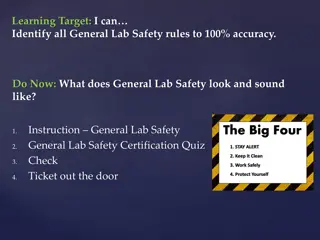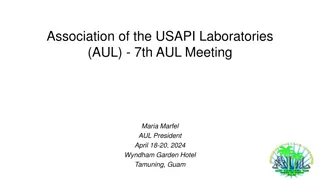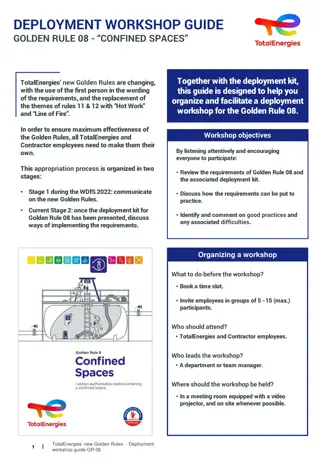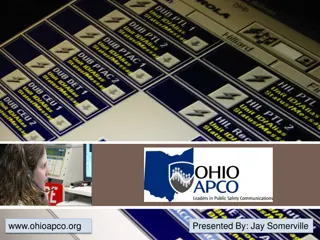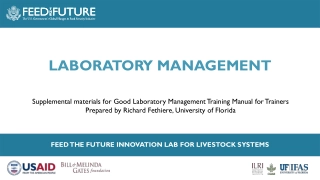General lab and safety Rules
Laboratory safety rules include guidelines on handling chemicals, wearing appropriate gear, and following proper procedures. Analytical chemistry involves qualitative and quantitative analysis methods using classical and instrumental approaches. Techniques such as gas chromatography, spectrophotometry, and volumetric measurements play a crucial role in this field.
- Laboratory Safety
- Analytical Chemistry
- Qualitative Analysis
- Quantitative Analysis
- Glassware Measurement
Download Presentation
Please find below an Image/Link to download the presentation.
The content on the website is provided AS IS for your information and personal use only. It may not be sold, licensed, or shared on other websites without obtaining consent from the author. Download presentation by click this link. If you encounter any issues during the download, it is possible that the publisher has removed the file from their server.
Presentation Transcript
General lab and safety Rules long hair Smoking Food gloves Never sit on the bench tops during lab. Read all chemical labels carefully Never return chemicals to the reagent bottle Always add acid to water Always wash your hands before leaving laboratory
The Analytical chemistry Analytical chemistry is branch of chemistry science deal with identification and separation of compounds and mixture, then determination of the proportions of the constituents. We have two types of analysis: A- Qualitative analysis: B- Quantitative analysis:
Qualitative Analysis Classical methods 1. Simple chemical test (inorganic & organic). 1. Gas chromatography (G.C). 2. Paper chromatography 2-Infrared (IR). 3. Thin layer chromatography 3.Nuclear magnetic resonance (NMR). 4. Analysis of ignition. 4. Mass Spectroscopy (MS). Instrumental methods Qualitative Analysis
Quantitative Analysis Classical methods Instrumental methods 1. Electrochemical analysis 2-Spectrophotometer. 1- Gravimetric analysis 2- Volumetric analysis a).Acid-base titration. b).Redox titration. c).Precipitation titration. d).Complex formation titration.
Experiment 1 Volumetric measurement glassware 1- Burette: A piece of glassware used for carefully measured volume of a liquid regent come in various sizes
2- Pipette: A piece of glassware used for measuring the volume of Iiquid comes in various sizes
3-Graduated cylinder: A piece of glassware used for measuring the volume of Iiquid comes in various sizes
4-Volumetric flask: A piece of glassware manufactured with capacities ranging from 5 ml to 5 liters , it is used in: a- preparation of standard solutions. b- In dilution of the concentrated solution.
5-Conical flask : A piece of glassware come in various sizes used for: a-titration b-Filtration c-Distillation d-Heating and evaporation
6-The beaker:A piece of glassware come in various sizes, used for: a- Dissolving the samples b- Transfer the solution c- Container of solution
7. Stirring glass rod:A piece of glassware come in various sizes ,used forMixing solven and solute.
8- Watch glass: A piece of glassware come in various sizes, manufactured from glass,using in: a- Weighing of non-hygroscopic material. b- Covering the beakers that contain heat solution. c- Covering the beakers during heat solution.
9- Spatula: A piece of laboratory tools used for transfer of solid material from a reagent bottle manufactured from steel and ceramic materials.
10-Polyethylene wash bottle: A piece of laboratory tool used for washing the glassware, manufactured from polyethylene
11- Brush: A piece of laboratory tool used for cleaning the glassware come in a various sizes.
14-Clamp (Buret clamp) (Double Buret clamp)
16-Funnel:A piece of glassware used for: a- Transfer the Liquids. b-In filtration
Method for the Expression of concentration 1- Formality the number of gram- formula weights of solute in one liter of solution ? = ?? ??? 1000 ???
2- Morality the number of gram- molecular weights (or moles) in one liter of solution ?? ?.?? 1000 ? = ??? 3-Normality: the number of gram- equivalent weight in one liter of the solution ? = ??.?? 1000 ?? ???
Equivalent weight of chemicals:- The definition of the equivalent weight for a chemical compound always refers to a specific chemical reaction evaluation of this quantity is impossible without knowledge of the nature of this reaction, always:- ??.??.=?.??. ? ; n = Equivalence For:- a). Acids equal a no. of H+ ions that react. 1. Inorganic acids n = no. of H in formula (HCl=1; HNO3=1; H3PO4=3; H2SO4=2; H2CO3=2). 2. Organic acids n = no. of COOH in formula (CH3COOH=1; HOOC-CH2-CH2-COOH=2). b). Basesequal a n =no. of OH- ions that react (NaOH =1; NH4OH=1; Al(OH)3=3; Ba(OH)2=2). c). Salts equal a no. of metals ion multiplied by the number of its oxidants:- {NaCl, KI, AgNO3=1}; { Na2CO3, Ca(NO3)2 , BaSO4, CaHPO4 = 2};{Na3PO4, Al(NO3)3 , Na3AsO4 = 3}; Ca3(PO4)2= 6 ; Al2(SO4)3 =6; NaHCO3 = 1 d). Redox reagents equal a no. of electron moles in reaction or the change in oxidation number of reagent: Fe +3 + e- Fe +2 n = 1 Sn +2 Sn +4 + 2e- n = 2 e). Ions equal a no. of ion charge: (Na+,NO3-,HCO3-,H2PO4-,K+=1),(Ca+2,Mg+2,SO4-2,CO3-2=2) (PO4 -3, Al+3 = 3)
Percent Concentration ???? ? ?? ?????? ???? ? ?? ???????? 100 Weight percent= ?????? ?? ?????? ?????? ?? ???????? 100 Volume percent = ???? ? ?? ??????.? ?????? ?? ???????? ?? 100 Weigh- Volume percent=
Preparation & Standardization 1-Solids Preparation (0.1N)of NaOH in250 ml ?? .???1000 ?? N = ??? V ml = 250 Eq. wt = Wt = X


